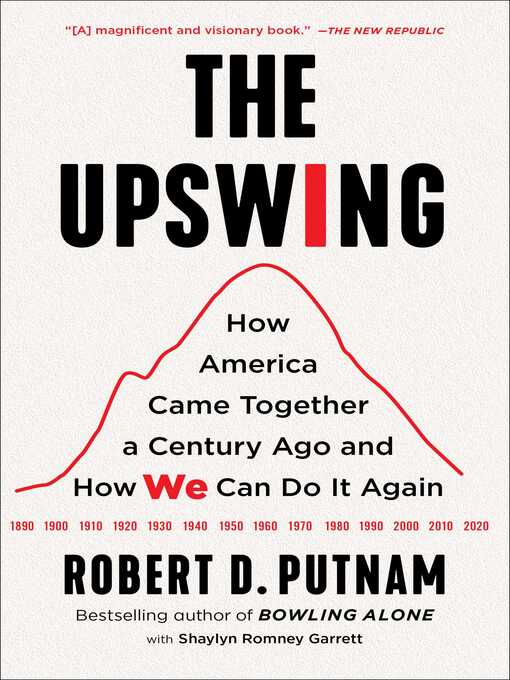
The Upswing
How America Came Together a Century Ago and How We Can Do It Again
فرمت کتاب
ebook
تاریخ انتشار
2020
نویسنده
Shaylyn Romney Garrettناشر
Simon & Schusterشابک
9781982129163
کتاب های مرتبط
- اطلاعات
- نقد و بررسی
- دیدگاه کاربران
نقد و بررسی

April 1, 2020
A top-notch addition to the why-America-is-in-such-a-mess genre. Writing with Garrett, Putnam, a professor of public policy at Harvard and winner of the National Humanities Medal, portrays a prosperous nation driven by technological innovation but burdened by massive, concentrated wealth and widespread poverty: Corruption and sex scandals fill the media; politics is gridlocked; xenophobia and white supremacist violence are rising; substance abuse runs rampant. The author then delivers a jolt by revealing that this describes Gilded Age America (1870-1890), a time when "doomsday prophecies and despairing anxieties" filled the media. Putnam's inverted-U graph illustrates what happened since. Four nearly parallel lines rise, tracking economic equality, goodwill in politics, community social bonds, and cultural altruism. All peak during the 1960s when, although far from perfect, "America had been transformed into a more egalitarian, cooperative, cohesive, and altruistic nation." Then all four steadily decline into the present. There follows an insightful history of what Putnam labels an "I-we-I century." Economic equality rose mostly through the explosion of education, high schools after 1900 and college after World War II and the Progressive movement, which produced government reform, encouraged unions, passed industrial regulation, and created the first social programs ("a veritable boom in association-building"). The first half of the 20th century gave birth to iconic social institutions such as the Rotary Club, NAACP, and the League of Woman Voters. Startlingly, both political parties contributed. About half of Republicans in Congress voted in favor of Progressive and New Deal programs, nearly two-thirds for Lyndon Johnson's Great Society. The number voting for Obamacare in 2010? Zero. The 1970s saw the steady decline of this so-called affability: "The collective norm that 'we're all in this together' was replaced by a libertarian...norm that we're not." The narrative is brilliantly argued throughout, although the traditional how-to-fix-it conclusion could use a more specific action plan. A tour de force exploration of why America got better and then went into reverse.
COPYRIGHT(2020) Kirkus Reviews, ALL RIGHTS RESERVED.

April 20, 2020
America’s deep-seated divisions were healed in the past and can be again, argues this sweeping and persuasive study. Harvard sociologist Putnam (Bowling Alone) and Aspen Institute strategist Garrett posit a 125-year “I-We-I” arc starting about 1890, during which America, through the Depression, World War II, and the postwar boom, saw a grand upsurge of “we”-centered community spirit, shared economic advancement, social solidarity, and political consensus. Unfortunately, they contend, the upheavals of the 1960s inaugurated a 50-year downswing into the current “I”-centered slough of narcissistic individualism, economic inequality, social isolation, and bitter political polarization. Putnam and Garrett tell this story in lucid prose illustrated with fascinating data on everything from taxes on the rich to marriage rates, the ratio of the words “we” and “I” in books, and the frequency of unusual baby names. While the authors explore possible causes for community unraveling—government policy, conservative backlash, do-your-own-thing liberalism, globalization—they eschew reductionist explanations. Less satisfyingly, they present no solutions besides vaguely reprising the 20th-century Progressive era’s mix of idealism and pragmatism. Still, this fresh, ambitious take on America’s fraying social fabric will provoke much discussion.

November 1, 2019
The Harvard professor best known for his best-selling, much-debated Bowling Alone again considers America's stretched-to-tearing social fabric, arguing that today's disaffected and self-interested society has a parallel in the Gilded Age of the late 1800s. But as he points out, by the early 1900s Americans were turning toward a more equitable society, and we can do it again. With a 75,000-copy first printing.
Copyright 2019 Library Journal, LLC Used with permission.

























دیدگاه کاربران